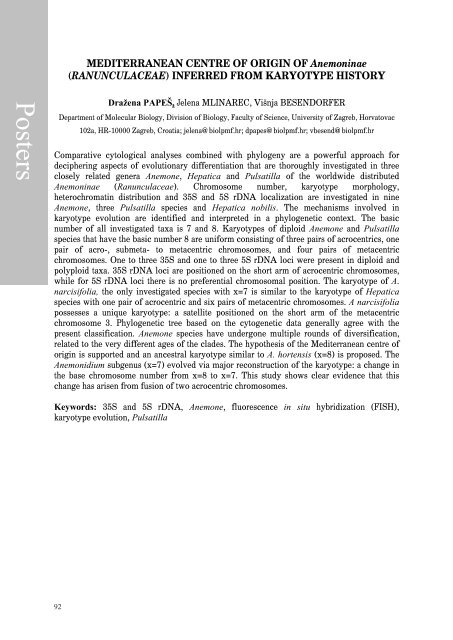Adil GÜNER, Vehbi ESER - optima
Adil GÜNER, Vehbi ESER - optima
Adil GÜNER, Vehbi ESER - optima
Create successful ePaper yourself
Turn your PDF publications into a flip-book with our unique Google optimized e-Paper software.
Posters<br />
92<br />
MEDITERRANEAN CENTRE OF ORIGIN OF Anemoninae<br />
(RANUNCULACEAE) INFERRED FROM KARYOTYPE HISTORY<br />
Dražena PAPEŠ, Jelena MLINAREC, Višnja BESENDORFER<br />
Department of Molecular Biology, Division of Biology, Faculty of Science, University of Zagreb, Horvatovac<br />
102a, HR-10000 Zagreb, Croatia; jelena@biolpmf.hr; dpapes@biolpmf.hr; vbesend@biolpmf.hr<br />
Comparative cytological analyses combined with phylogeny are a powerful approach for<br />
deciphering aspects of evolutionary differentiation that are thoroughly investigated in three<br />
closely related genera Anemone, Hepatica and Pulsatilla of the worldwide distributed<br />
Anemoninae (Ranunculaceae). Chromosome number, karyotype morphology,<br />
heterochromatin distribution and 35S and 5S rDNA localization are investigated in nine<br />
Anemone, three Pulsatilla species and Hepatica nobilis. The mechanisms involved in<br />
karyotype evolution are identified and interpreted in a phylogenetic context. The basic<br />
number of all investigated taxa is 7 and 8. Karyotypes of diploid Anemone and Pulsatilla<br />
species that have the basic number 8 are uniform consisting of three pairs of acrocentrics, one<br />
pair of acro-, submeta- to metacentric chromosomes, and four pairs of metacentric<br />
chromosomes. One to three 35S and one to three 5S rDNA loci were present in diploid and<br />
polyploid taxa. 35S rDNA loci are positioned on the short arm of acrocentric chromosomes,<br />
while for 5S rDNA loci there is no preferential chromosomal position. The karyotype of A.<br />
narcisifolia, the only investigated species with x=7 is similar to the karyotype of Hepatica<br />
species with one pair of acrocentric and six pairs of metacentric chromosomes. A narcisifolia<br />
possesses a unique karyotype: a satellite positioned on the short arm of the metacentric<br />
chromosome 3. Phylogenetic tree based on the cytogenetic data generally agree with the<br />
present classification. Anemone species have undergone multiple rounds of diversification,<br />
related to the very different ages of the clades. The hypothesis of the Mediterranean centre of<br />
origin is supported and an ancestral karyotype similar to A. hortensis (x=8) is proposed. The<br />
Anemonidium subgenus (x=7) evolved via major reconstruction of the karyotype: a change in<br />
the base chromosome number from x=8 to x=7. This study shows clear evidence that this<br />
change has arisen from fusion of two acrocentric chromosomes.<br />
Keywords: 35S and 5S rDNA, Anemone, fluorescence in situ hybridization (FISH),<br />
karyotype evolution, Pulsatilla<br />
28






